Xuefei Ning
On the Ability of LLMs to Handle Character-Level Perturbations: How Well and How?
Oct 16, 2025Abstract:This work investigates the resilience of contemporary LLMs against frequent and structured character-level perturbations, specifically through the insertion of noisy characters after each input character. We introduce \nameshort{}, a practical method that inserts invisible Unicode control characters into text to discourage LLM misuse in scenarios such as online exam systems. Surprisingly, despite strong obfuscation that fragments tokenization and reduces the signal-to-noise ratio significantly, many LLMs still maintain notable performance. Through comprehensive evaluation across model-, problem-, and noise-related configurations, we examine the extent and mechanisms of this robustness, exploring both the handling of character-level tokenization and \textit{implicit} versus \textit{explicit} denoising mechanism hypotheses of character-level noises. We hope our findings on the low-level robustness of LLMs will shed light on the risks of their misuse and on the reliability of deploying LLMs across diverse applications.
Latent Zoning Network: A Unified Principle for Generative Modeling, Representation Learning, and Classification
Sep 19, 2025Abstract:Generative modeling, representation learning, and classification are three core problems in machine learning (ML), yet their state-of-the-art (SoTA) solutions remain largely disjoint. In this paper, we ask: Can a unified principle address all three? Such unification could simplify ML pipelines and foster greater synergy across tasks. We introduce Latent Zoning Network (LZN) as a step toward this goal. At its core, LZN creates a shared Gaussian latent space that encodes information across all tasks. Each data type (e.g., images, text, labels) is equipped with an encoder that maps samples to disjoint latent zones, and a decoder that maps latents back to data. ML tasks are expressed as compositions of these encoders and decoders: for example, label-conditional image generation uses a label encoder and image decoder; image embedding uses an image encoder; classification uses an image encoder and label decoder. We demonstrate the promise of LZN in three increasingly complex scenarios: (1) LZN can enhance existing models (image generation): When combined with the SoTA Rectified Flow model, LZN improves FID on CIFAR10 from 2.76 to 2.59-without modifying the training objective. (2) LZN can solve tasks independently (representation learning): LZN can implement unsupervised representation learning without auxiliary loss functions, outperforming the seminal MoCo and SimCLR methods by 9.3% and 0.2%, respectively, on downstream linear classification on ImageNet. (3) LZN can solve multiple tasks simultaneously (joint generation and classification): With image and label encoders/decoders, LZN performs both tasks jointly by design, improving FID and achieving SoTA classification accuracy on CIFAR10. The code and trained models are available at https://github.com/microsoft/latent-zoning-networks. The project website is at https://zinanlin.me/blogs/latent_zoning_networks.html.
How Quantization Shapes Bias in Large Language Models
Aug 25, 2025Abstract:This work presents a comprehensive evaluation of how quantization affects model bias, with particular attention to its impact on individual demographic subgroups. We focus on weight and activation quantization strategies and examine their effects across a broad range of bias types, including stereotypes, toxicity, sentiment, and fairness. We employ both probabilistic and generated text-based metrics across nine benchmarks and evaluate models varying in architecture family and reasoning ability. Our findings show that quantization has a nuanced impact on bias: while it can reduce model toxicity and does not significantly impact sentiment, it tends to slightly increase stereotypes and unfairness in generative tasks, especially under aggressive compression. These trends are generally consistent across demographic categories and model types, although their magnitude depends on the specific setting. Overall, our results highlight the importance of carefully balancing efficiency and ethical considerations when applying quantization in practice.
FilMaster: Bridging Cinematic Principles and Generative AI for Automated Film Generation
Jun 23, 2025Abstract:AI-driven content creation has shown potential in film production. However, existing film generation systems struggle to implement cinematic principles and thus fail to generate professional-quality films, particularly lacking diverse camera language and cinematic rhythm. This results in templated visuals and unengaging narratives. To address this, we introduce FilMaster, an end-to-end AI system that integrates real-world cinematic principles for professional-grade film generation, yielding editable, industry-standard outputs. FilMaster is built on two key principles: (1) learning cinematography from extensive real-world film data and (2) emulating professional, audience-centric post-production workflows. Inspired by these principles, FilMaster incorporates two stages: a Reference-Guided Generation Stage which transforms user input to video clips, and a Generative Post-Production Stage which transforms raw footage into audiovisual outputs by orchestrating visual and auditory elements for cinematic rhythm. Our generation stage highlights a Multi-shot Synergized RAG Camera Language Design module to guide the AI in generating professional camera language by retrieving reference clips from a vast corpus of 440,000 film clips. Our post-production stage emulates professional workflows by designing an Audience-Centric Cinematic Rhythm Control module, including Rough Cut and Fine Cut processes informed by simulated audience feedback, for effective integration of audiovisual elements to achieve engaging content. The system is empowered by generative AI models like (M)LLMs and video generation models. Furthermore, we introduce FilmEval, a comprehensive benchmark for evaluating AI-generated films. Extensive experiments show FilMaster's superior performance in camera language design and cinematic rhythm control, advancing generative AI in professional filmmaking.
AgentSociety Challenge: Designing LLM Agents for User Modeling and Recommendation on Web Platforms
Feb 26, 2025Abstract:The AgentSociety Challenge is the first competition in the Web Conference that aims to explore the potential of Large Language Model (LLM) agents in modeling user behavior and enhancing recommender systems on web platforms. The Challenge consists of two tracks: the User Modeling Track and the Recommendation Track. Participants are tasked to utilize a combined dataset from Yelp, Amazon, and Goodreads, along with an interactive environment simulator, to develop innovative LLM agents. The Challenge has attracted 295 teams across the globe and received over 1,400 submissions in total over the course of 37 official competition days. The participants have achieved 21.9% and 20.3% performance improvement for Track 1 and Track 2 in the Development Phase, and 9.1% and 15.9% in the Final Phase, representing a significant accomplishment. This paper discusses the detailed designs of the Challenge, analyzes the outcomes, and highlights the most successful LLM agent designs. To support further research and development, we have open-sourced the benchmark environment at https://tsinghua-fib-lab.github.io/AgentSocietyChallenge.
Token Pruning for Caching Better: 9 Times Acceleration on Stable Diffusion for Free
Dec 31, 2024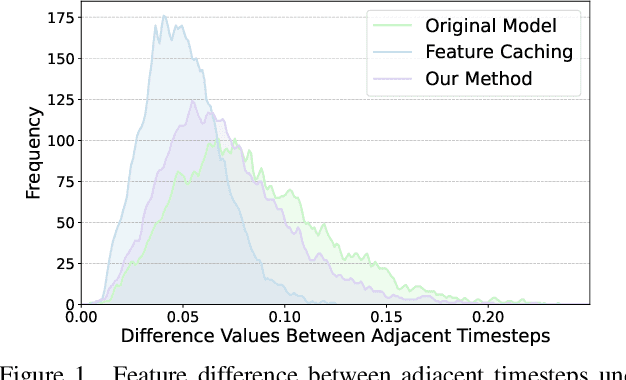
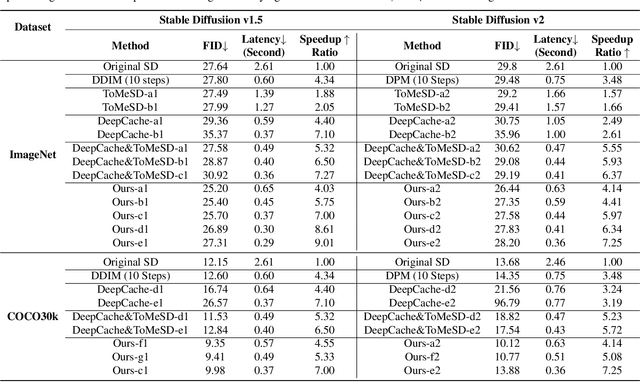
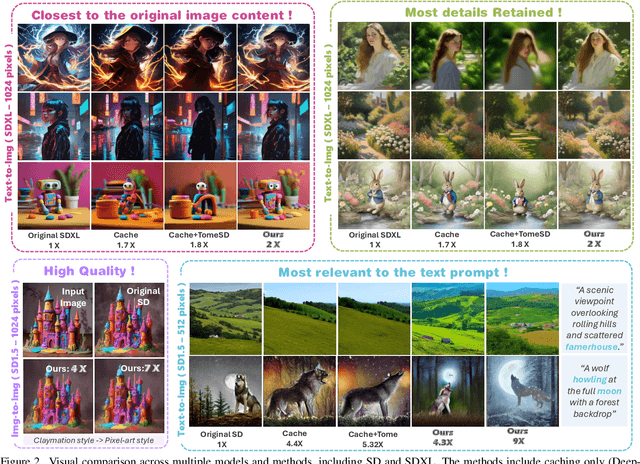

Abstract:Stable Diffusion has achieved remarkable success in the field of text-to-image generation, with its powerful generative capabilities and diverse generation results making a lasting impact. However, its iterative denoising introduces high computational costs and slows generation speed, limiting broader adoption. The community has made numerous efforts to reduce this computational burden, with methods like feature caching attracting attention due to their effectiveness and simplicity. Nonetheless, simply reusing features computed at previous timesteps causes the features across adjacent timesteps to become similar, reducing the dynamics of features over time and ultimately compromising the quality of generated images. In this paper, we introduce a dynamics-aware token pruning (DaTo) approach that addresses the limitations of feature caching. DaTo selectively prunes tokens with lower dynamics, allowing only high-dynamic tokens to participate in self-attention layers, thereby extending feature dynamics across timesteps. DaTo combines feature caching with token pruning in a training-free manner, achieving both temporal and token-wise information reuse. Applied to Stable Diffusion on the ImageNet, our approach delivered a 9$\times$ speedup while reducing FID by 0.33, indicating enhanced image quality. On the COCO-30k, we observed a 7$\times$ acceleration coupled with a notable FID reduction of 2.17.
FrameFusion: Combining Similarity and Importance for Video Token Reduction on Large Visual Language Models
Dec 30, 2024
Abstract:The increasing demand to process long and high-resolution videos significantly burdens Large Vision-Language Models (LVLMs) due to the enormous number of visual tokens. Existing token reduction methods primarily focus on importance-based token pruning, which overlooks the redundancy caused by frame resemblance and repetitive visual elements. In this paper, we analyze the high vision token similarities in LVLMs. We reveal that token similarity distribution condenses as layers deepen while maintaining ranking consistency. Leveraging the unique properties of similarity over importance, we introduce FrameFusion, a novel approach that combines similarity-based merging with importance-based pruning for better token reduction in LVLMs. FrameFusion identifies and merges similar tokens before pruning, opening up a new perspective for token reduction. We evaluate FrameFusion on diverse LVLMs, including Llava-Video-{7B,32B,72B}, and MiniCPM-V-8B, on video understanding, question-answering, and retrieval benchmarks. Experiments show that FrameFusion reduces vision tokens by 70$\%$, achieving 3.4-4.4x LLM speedups and 1.6-1.9x end-to-end speedups, with an average performance impact of less than 3$\%$. Our code is available at https://github.com/thu-nics/FrameFusion.
MBQ: Modality-Balanced Quantization for Large Vision-Language Models
Dec 27, 2024



Abstract:Vision-Language Models (VLMs) have enabled a variety of real-world applications. The large parameter size of VLMs brings large memory and computation overhead which poses significant challenges for deployment. Post-Training Quantization (PTQ) is an effective technique to reduce the memory and computation overhead. Existing PTQ methods mainly focus on large language models (LLMs), without considering the differences across other modalities. In this paper, we discover that there is a significant difference in sensitivity between language and vision tokens in large VLMs. Therefore, treating tokens from different modalities equally, as in existing PTQ methods, may over-emphasize the insensitive modalities, leading to significant accuracy loss. To deal with the above issue, we propose a simple yet effective method, Modality-Balanced Quantization (MBQ), for large VLMs. Specifically, MBQ incorporates the different sensitivities across modalities during the calibration process to minimize the reconstruction loss for better quantization parameters. Extensive experiments show that MBQ can significantly improve task accuracy by up to 4.4% and 11.6% under W3 and W4A8 quantization for 7B to 70B VLMs, compared to SOTA baselines. Additionally, we implement a W3 GPU kernel that fuses the dequantization and GEMV operators, achieving a 1.4x speedup on LLaVA-onevision-7B on the RTX 4090. The code is available at https://github.com/thu-nics/MBQ.
Distilled Decoding 1: One-step Sampling of Image Auto-regressive Models with Flow Matching
Dec 24, 2024Abstract:Autoregressive (AR) models have achieved state-of-the-art performance in text and image generation but suffer from slow generation due to the token-by-token process. We ask an ambitious question: can a pre-trained AR model be adapted to generate outputs in just one or two steps? If successful, this would significantly advance the development and deployment of AR models. We notice that existing works that try to speed up AR generation by generating multiple tokens at once fundamentally cannot capture the output distribution due to the conditional dependencies between tokens, limiting their effectiveness for few-step generation. To address this, we propose Distilled Decoding (DD), which uses flow matching to create a deterministic mapping from Gaussian distribution to the output distribution of the pre-trained AR model. We then train a network to distill this mapping, enabling few-step generation. DD doesn't need the training data of the original AR model, making it more practical. We evaluate DD on state-of-the-art image AR models and present promising results on ImageNet-256. For VAR, which requires 10-step generation, DD enables one-step generation (6.3$\times$ speed-up), with an acceptable increase in FID from 4.19 to 9.96. For LlamaGen, DD reduces generation from 256 steps to 1, achieving an 217.8$\times$ speed-up with a comparable FID increase from 4.11 to 11.35. In both cases, baseline methods completely fail with FID>100. DD also excels on text-to-image generation, reducing the generation from 256 steps to 2 for LlamaGen with minimal FID increase from 25.70 to 28.95. As the first work to demonstrate the possibility of one-step generation for image AR models, DD challenges the prevailing notion that AR models are inherently slow, and opens up new opportunities for efficient AR generation. The project website is at https://imagination-research.github.io/distilled-decoding.
GenMAC: Compositional Text-to-Video Generation with Multi-Agent Collaboration
Dec 05, 2024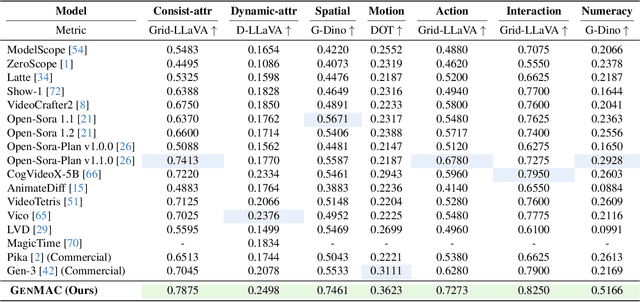

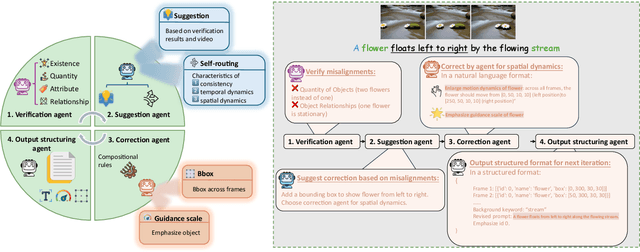
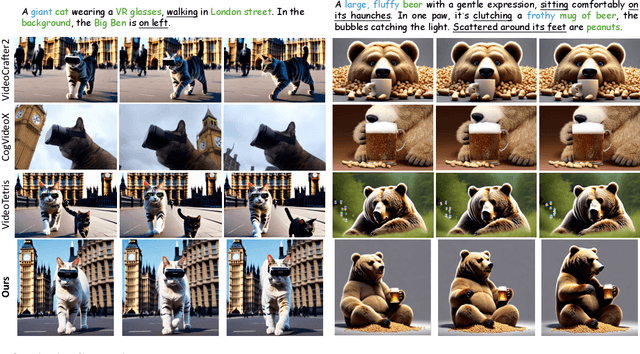
Abstract:Text-to-video generation models have shown significant progress in the recent years. However, they still struggle with generating complex dynamic scenes based on compositional text prompts, such as attribute binding for multiple objects, temporal dynamics associated with different objects, and interactions between objects. Our key motivation is that complex tasks can be decomposed into simpler ones, each handled by a role-specialized MLLM agent. Multiple agents can collaborate together to achieve collective intelligence for complex goals. We propose GenMAC, an iterative, multi-agent framework that enables compositional text-to-video generation. The collaborative workflow includes three stages: Design, Generation, and Redesign, with an iterative loop between the Generation and Redesign stages to progressively verify and refine the generated videos. The Redesign stage is the most challenging stage that aims to verify the generated videos, suggest corrections, and redesign the text prompts, frame-wise layouts, and guidance scales for the next iteration of generation. To avoid hallucination of a single MLLM agent, we decompose this stage to four sequentially-executed MLLM-based agents: verification agent, suggestion agent, correction agent, and output structuring agent. Furthermore, to tackle diverse scenarios of compositional text-to-video generation, we design a self-routing mechanism to adaptively select the proper correction agent from a collection of correction agents each specialized for one scenario. Extensive experiments demonstrate the effectiveness of GenMAC, achieving state-of-the art performance in compositional text-to-video generation.
 Add to Chrome
Add to Chrome Add to Firefox
Add to Firefox Add to Edge
Add to Edge